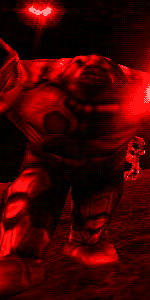THE HISTORY OF

This is an article I found on the Net which I found very interesting. It describes how Unreal got started and the hurdles it had to overcome. I wanted to post it here, just in case the original website ever decided to nuke it.
Because with me, Unreal will live forever, and so will this website.
|
| By Geoffrey Keighley (editor@gameslice.com) Late one night - or early one morning, depending on how you look at it - four years ago, the story of Unreal began. It started in the unassuming town of Rockville, MD, when a Mariachi band started to play in the apartment complex that housed game developers Epic MegaGames.
At 5:00 a.m., the last thing three game designers wanted to hear was the cadence of Mexican pomp seeping through their walls. After all, in the gaming world, 5:00 a.m. isn't when the rooster cock-a-doodle-doos; it's when the lights finally get turned out after an intense night of programming.
Being a game developer has never been mainstream, and back in those days, it certainly wasn't glamorous. The self-dubbed "Epic Apartment" in Rockville was about as bland a development studio as you'll find. But it was the think tank where Epic MegaGames founder Tim Sweeney housed his ace developers as they burned the midnight oil trying to polish their latest games.
That night, young Canadian-born game designer James Schmalz had made a decision. He was ready to show fellow designer Cliff Bleszinski the first working prototype of his new game. It would be the follow-up to his previous effort, a surprise-hit pinball simulation called Extreme Pinball. Although the demo of his next game was merely speculative research at this point - little more than solid lines flying around on a grid onscreen - it was the first step toward Schmalz's goal of creating what he called "a Magic Carpet-like environment where you fly through caverns with robots."
Thus the story of Unreal begins. Although the concept would change from caves to castles, and the graphics would transpose from rough lines to luscious textures, four years later, Schmalz and Bleszinski, along with ace programmer and company founder Tim Sweeney, would have arguably the biggest PC game of the year on their hands.
Getting there wasn't easy. Obstacles were everywhere - from uniting a battalion of developers scattered across the globe, to withstanding the scathing criticism of the press, to competing with companies ten times their size.
But succeed they did. This is their story... |  |
 |
Action Aficionados
The day after Schmalz's fateful decision to show the prototype, the Epic Apartment was, as usual, entwined in a sea of cables that connected an ungodly number of computers - machines that were supposed to be used for software development. At the time, Bleszinski, then a California high-school senior (complete with pony-tail), was attempting to finish up his new adventure game, Jazz Jackrabbit, while Schmalz was tinkering with the demo that would eventually become Unreal.
Progress was slow. Although software development was their full-time job, Bleszinski and Schmalz were gamers, too, and 1994 was the golden age of Doom. Id Software's first-person shooter was the rage of the industry - a palpable, adrenaline-laced, run-and-gun action phenomena. And Schmalz and Bleszinski were not immune. "The bottom line is that we played a lot of multiplayer deathmatch," says Bleszinski - to the point where they had to hide their habit from company founder Tim Sweeney. "About twice a day, Tim would come over to the apartment to see how things were going on our games - the games we were supposed to be working on. So, when Tim knocked on the door, we'd be in the middle of playing our daily dose of deathmatch. Surprisingly, as soon as the door opened, all the computers would mysteriously be rebooting. 'Oh gee Tim, all the computers just crashed!' we'd tell him."
Weeks passed, and Schmalz - who does most of the programming, art, and design for his games - was still toying around with his technology demo. "At that point, the game was going to be really small. It was just me doing my own thing," he says. But as work progressed, he decided to take some risks. "I added textures to the environment to make it richer and took off the ceiling of the caverns to see if I could do an outdoor game. Then, medieval elements were added, and I started to add buildings to the environment. It really started looking good, but I needed to crystallize my ideas into a real vision for the product."
Enter Tim Sweeney, the University of Maryland-grad and programming-genius-turned-Epic-founder. When Sweeney saw Schmalz mapping a demo level on a piece of paper, he realized Schmalz was working in the development equivalent of the Stone Age. "Tim couldn't believe James was mapping things out on paper," remembers Epic's VP of marketing, the ebullient Mark Rein. "So Tim said, 'Hey James, I'm going to build you an editor!'" Sweeney set to work building a computerized palette of shapes and brushes that would make it much easier to build a game environment.
As work progressed on both the demo and the level editor, the excitement - and the trepidation - began to build. The development team didn't know what the demo was going to turn into, but it was becoming clear that it had the potential to take Epic into an entirely new direction. "Up until that point, we had made some pretty cool little platform games and pinball games, but no one really took us very seriously," says a blunt Bleszinski. "We needed to make a huge splash with this game." |
From Carpet to Foot
Before development could go much further, the team had to nail down the thematic aspect of the game. "Just like everyone else in the industry, we thought medieval would be the way to go. But then we said, 'Hey, wait a minute, we want guns!'" As time passed and the brainstorming sessions increased in frequency and complexity, Schmalz decided to set the game in a mystical world where the player would be uncertain about his surroundings. This led to a juxtaposition of seemingly disparate gaming elements. "We finally crystallized on the idea of this game being in a medieval world, with aliens to give it a sci-fi feel," Schmalz explains.
As work on Sweeney's design toolbox continued, it soon became evident that the graphic engine was capable of great indoor environments as well as outdoor settings. And that opened up the possibility of creating a Doom-style first-person shooter instead of the original concept, which revolved around a flying carpet. Epic thought long and hard about going down this path. Although the designers felt their graphic technology would be a match for anything else on the market, it was not at all clear that they had the resources necessary to develop a game as good as Doom (let alone the newly announced Quake).
After all, Epic was just a small company, and the developers were a small sub-section of that. They knew they needed more resources. Even with help from the outside, going head-to-head with id Software - developers of the biggest and best 3D technology in the industry - wasn't going to be a walk in the park. Despite the obstacles and an uncertain outcome, Epic decided to roll the dice and do its best to make the next great first-person shooter. By now, Schmalz had given most of the control of the engine's development to Tim Sweeney, the affable programmer who GT Interactive chairman and CEO Ron Chaimowitz refers to as "clearly one of our industry's geniuses." But even Sweeney has his heroes - namely id Software's John Carmack. Sweeney's praise of Carmack's influence leaves little room for interpretation: "Much in the same way that no man will ever top Isaac Newton's contributions to physics, Carmack will always remain way ahead in his total contribution to the gaming field, having invented the first-person shooter genre, the multiplayer model for gaming we know today, and much more."
For Sweeney, who founded Epic based on a little-known game called ZZT, developing the engine for Unreal would not only be his biggest programming task ever, but his attempt to beat Carmack at his own game. |  |
 | Tools of the Trade
To match id Software's efforts, Sweeney knew that Epic's game must be a technical masterpiece. Sitting at his digital spinning wheel for weeks on end, his goal was to create a graphic shell that would allow for a visually rich and lush game environment. "Artistically, we looked at Myst and Riven and wanted to go for that quality of art and variety in the levels," he recalls. "We wanted to model a large variety of areas one would see on an alien planet - beautiful temples and castles, large outdoor expanses, crashed space vessels, and mines. We wanted to create an experience that varies from dramatic to scary to mysterious."
Developing the toolset to sculpt these environments would prove to be much more difficult than expected, especially since Epic had the dual goal of creating cutting-edge technology and a cutting-edge game simultaneously. The task is roughly the equivalent of a filmmaker developing a new kind of film on which to shoot his movie or a musician developing a new instrument on which to play his music. Although this approach was necessary to achieve the best result, Bleszinski remembers, "It was frustrating because you'd take three steps forward but four steps back lots of times. We'd see a cool new effect Tim had developed, but just sort of chuckle and say under our breath, 'Looks great, but what parts of the engine did you break to do this?'" Eventually the effort would pay off, and the effects that Sweeney developed for the engine would change the face of what gamers expected from a first-person 3D action game. One of the first technical improvements over previous shooters was the use of 16-bit or "real" color environments, as opposed to the previous standard of 8-bits, which only let 256 colors be displayed simultaneously. John Carmack of id Software says that Unreal broke the mold by going to real color. "I doubt any important game will be designed with 8-bit color in mind from now on. Unreal has done an important thing in pushing toward direct color, and this gives the artists a lot more freedom."
Other effects that Sweeney would dream up created room for even greater visual realism. Sweeney, an avid runner and in-line skater, remembers, "I was out on a six-mile run late at night after a rain storm, with the streetlights casting luminous spheres of light in the fog. I was thinking, 'Gee, I should be able to program that effect.' But when I got back to the office, I second-guessed myself. A few months later, on a whim, I spent a couple of hours whipping up code for this, and to my amazement, it worked perfectly." Sweeney's efforts in this area draws more praise from Carmack: "Light blooms [the spheres of light], fog volumes, and composite skies were steps I was planning on taking, but Epic got there first with Unreal." |
Sculpt Your Own World
The decision to create an easy-to-use editor that would actually include the 3D game engine was another key development. As Rein explains, "The building tools and the engine Tim made are one and the same - they work in tandem so the integration makes things a lot easier. Lots of companies have one guy working on the tools and one guy doing the engine, but that leads to confusion. You can't see where the engine ends and the editor begins with our product. It's seamless." With the editor, users could easily create their own levels, a key selling point of the product and a big competitive advantage over other engines.
As development progressed, the number of special effects incorporated into the engine grew by leaps and bounds. But creating such cutting-edge technology was taxing. Sweeney sums it up by stating, "3D engine programming is often three months of hard and mundane work followed by a revelation and three hours of coding that creates a dramatic leap forward." And what a leap forward it turned out to be. According to Carmack, "The Unreal engine has raised the bar on what action gamers expect from future products. The visual effects first seen in the game will become expected from future games." But visuals are only one fraction of the equation that yields a hit game. Epic still had to sculpt the game environment - that mysterious mix of sci-fi and medieval castles that was the original vision for the shooter. Molding the game and its story into an unstable technology base would prove to be extremely difficult. As Tim Sweeney remembers, "Level designers must build levels before they know how the artificial intelligence works, before the engine is running at a decent speed, and before major software errors are fixed. Everyone must make lots of guesses about how the pieces will fit together and do lots of reworking when those pieces don't fit."
Even with the difficulties, Schmalz and Bleszinski became increasingly convinced that the potential for their game was almost unlimited. "Quickly, my focus shifted from doing a game that was going to do well to doing a number one game," recalls Schmalz. "We wanted to go all the way and pull out all the stops." But the team was still small, and it needed to move beyond the core group of developers to seed the engine with enough creative talent to let it blossom into a full and immersive game. Time to take out classified ads? Not quite. |  |
 | Virtual Recruitment
The Internet has long been a hot breeding ground for fans of 3D action games, and Epic knew it. So when it started fleshing out the team for the game, it was only logical to turn to the cyber realm. For instance, the man hired for the game's artificial intelligence was well-known for his famous Reaper Bots add-on for Quake (the program adds realistic computer-controlled human opponents to the multiplayer game). Rein remembers that he was on the Internet IRC chat at a hotel in Europe when he first heard of Reaper Bots. "Some users said during the chat, 'Hey Mark, have you seen the Reaper Bots?' I hadn't, but I downloaded them and was addicted. For me, it was the perfect way to practice for multiplayer.
So the next day, I found the phone number of Steve Polge who created them, called him, and he was hired within a month as our artificial intelligence guy." Other employees would be hired in a similar fashion, usually based on their previous work published on the Internet. At the same time, this process of hiring the best of the Internet would lead to a development team scattered all over the world. Schmalz and his core group of artists would be branded as Digital Extremes and remain in Canada, but everyone else was all over the map - from the Netherlands to the US to Canada to France. As the team started to ramp up, members would communicate via e-mail and phone to discuss their vision for the game. Just as the team was growing, the game was turning into Epic's largest project ever in terms of resources and investment. It deserved a huge push and Epic knew it - Epic had to tell the world that a new era for the company was about to begin. Pinball tables and carrot-munching jackrabbits need not apply. |
The Hype Begins
Mark Rein, Epic's VP of marketing and former president of id Software, knew the team had something special brewing. He wanted to show the world what was in development and chose the 1996 Electronic Entertainment Expo as the venue. So, in a suite at the Marriott in Marina Del Ray, CA, Rein, Sweeney, Schmalz, and Bleszinski premiered the game technology. Promoting the use of the MMX processor from Intel for enhanced visual effects on a computer monitor that sat near an open window with palm trees swaying in the background, they demonstrated the technology to the press and a select group of industry insiders. Although there wasn't much of a game to be shown, the visuals were very impressive - colored lights illuminated the environment and blended with each other. And the editor shown by Bleszinski was truly revolutionary, making level-building virtually a point-and-click process. These demos would continue for the next two years as Rein and PR manager Craig Lafferty churned out more and more buzz and hype about the game. The Name of the Game
But what would the game be called? The developers fought forever about names, going through a number of options including Sin and Dark Earth - ironic, considering the fact that two PC games have since taken those names. Finally, "Everyone gave up," says Schmalz, and they settled on the pompous name Unreal. In retrospect, the name couldn't have been better - it was cocky, memorable, and indicative of the team's confidence that it was pushing into uncharted territory.
The first big wave of public interest in Unreal came in late 1996 when PC Gamer ran the first preview of the game. Epic basked in the glow of the publicity, but promoting its new title at such an early stage proved to be a double-edged sword. The developers were creating incredible expectations for Unreal and building the hype to pressure-cooker levels. According to Rein, it was a necessary evil. "To attract publisher interest, it was necessary for little Epic MegaGames to go out and show off its technology," he says, recalling the initial PR blitz. "If we hadn't done that, our deal would have been half of what it is. The good thing is that we always had these expectations standing over our shoulders keeping us honest, but the bad thing is that we showed our cards to the world ahead of time." |  |
 | The 51 Billion Dollar Demo
Showing their cards to the world ahead of time would present a number of intriguing demo experiences for the Unreal team members. They had potentially revolutionary graphics technology at their fingertips and everyone wanted to see it - from the biggest software publishers in the industry down to cult-heroes such as John Carmack and John Romero. Eventually, in early 1997, Epic would give the biggest demo possible, to none other than Microsoft CEO Bill Gates. This top-secret meeting - never before revealed to the public - took place inside the Microsoft compound in Redmond, WA. Rein and Sweeney met with Gates and a number of his leading developers to show them what they were doing with Unreal. After Sweeney discussed the technology and Rein ran a demo of the game, they sat down with Gates one-on-one to discuss their work. "He was really very gracious and complementary of the game," remembers Rein. For Sweeney, "Showing Unreal to Bill Gates was a very cool experience, and it drove home the point that if you work very hard for many years and strive to be one of the best in your field, you really can get there and see some great opportunities." |
Onward to Part 2
Interested in seeing screenshots from Unreal's beginning?
CLICK HERE







